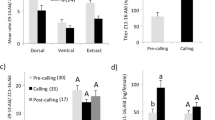Abstract
Airborne volatiles of saturated and unsaturated acetates and alcohols with the dodecane, tetradecane, and hexadecane chains released from fresh polyethylene pheromone dispensers were collected in Pasteur pipets attached to an all-glass collecting system. A maximum of 300–500 ng of pheromone in the first pipet (in a row of three or four) could be accumulated. The total amount that can be collected from an active rich source in 10–15 min of aeration (at 40–50 ml/min/cage) can reach 0.5–1 μg. Breakthrough from a pipet starts after an accumulation of 40–50 ng. There is a direct relationship among airflow rate in the system, the period of collection, and the vapor pressure of the chemicals on the amount adsorbed on the glass surface of the pipets. Polar functionalities, such as hydrogen bonding and π electrons play a significant role in the strength of adsorption to the glass surface. The system and technique are simple, fast, and easy to handle for collection of airborne volatiles from plants, animals, and nonliving sources.
Similar content being viewed by others
REFERENCES
BARRER, P. M.,LACEY, M. J., andSHANI, A. 1987. Variation in relative quantities of airborne sex pheromone components from individual femaleEphestia cautella (Lepidoptera: Pyralidae).J. Chem. Ecol. 13:639–653.
BRADLEY, S. J.,SUCKLING, D. M.,MC NAUGHTON, K. G.,WEARING, C. H., andKARG, G. 1995. A temperature-dependent model for predicting release rates of pheromone from a polyethylene tubing dispenser.J. Chem. Ecol. 21:745–760.
BROWN, D. F.,KNIGHT, A. L.,HOWELL, J. F.,SELL, C. R.,KRYSAN, J. L., andWEISS, M. 1992. Emission characteristics of a polyethylene pheromone dispenser for mating disruption of codling moth (Lepidoptera: Tortricidae).J. Econ. Entomol. 85:910–917.
BUTLER, L. I., andMC DONOUGH, L. M. 1981. Insect sex pheromones. Evaporation rates of alcohols and acetates from natural rubber septa.J. Chem. Ecol. 7:627–633.
GOLUB, M. A., andWEATHERSTON, I. 1984. Techniques for extracting and collecting sex pheromones from live insects and from artificial sources, pp. 223–285,in H. E. Hummel and T. A. Miller (eds.). Techniques in Pheromone Research. Springer-Verlag, New York.
HEATH, R. R.,TEAL, P. E. A.,TUMLINSON, J. H., andMENGELKOCH, L. J. 1986. Prediction of release ratios of multicomponent pheromones from rubber septa.J. Chem. Ecol. 12:2133–2143.
LACEY, M. J., andSANDERS, C. J. 1992. Chemical composition of sex pheromone of oriental fruit moth and rates of release by individual female moth.J. Chem. Ecol. 18:1421–1435.
MC DONOUGH, L. M., andBUTLER, L. I. 1983. Insect sex pheromones: Determination of half-lives from formulations by collection of emitted vapor.J. Chem. Ecol. 9:1491–1502.
MC DONOUGH, L. M.,BROWN, D. F., andALLER, W. C. 1989. Insect sex pheromones: Effect of temperature on evaporation rates of acetates from rubber septa.J. Chem. Ecol. 15:779–790.
MC DONOUGH, L. M.,ALLER, W. C., andKNIGHT, A. L. 1992. Performance characteristics of a commercial controlled-release dispenser of sex pheromone for control of coding moth (Cydia pomonella) by mating disruption.J. Chem. Ecol. 18:2177–2189.
SHANI, A. 1990. Calling behavior of almond moth (Ephestia cautella) females kept in glass cages and airborne pheromone deposited on glass surfaces by airstream.J. Chem. Ecol. 16:959–969.
SHANI, A., andLACEY, M. J. 1984. Convenient method applicable to single insects for collection and measurement of blend ratios of airbome pheromones from artificial sources.J. Chem. Ecol. 10:1677–1692.
VAN DER KKRAAN, C., andEBBERS, A. 1990. Release rates of tetradecen-1-o1 acetates from polymeric formulations in relation to temperature and air velocity.J. Chem. Ecol. 16:1041–1058.
WITZGALL, P., andFREROT, B. 1989. Pheromone emission by individual fernales of carnation tortrix,Cocoecimorpha pronubana.J. Chem. Ecol. 15:707–717.
Author information
Authors and Affiliations
Rights and permissions
About this article
Cite this article
Shani, A., Clearwater, J. How Efficient are All-Glass Systems for Collection of Airborne Volatiles?. J Chem Ecol 23, 1621–1633 (1997). https://doi.org/10.1023/B:JOEC.0000006426.90059.4e
Issue Date:
DOI: https://doi.org/10.1023/B:JOEC.0000006426.90059.4e




